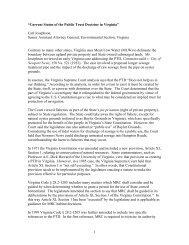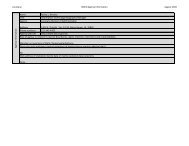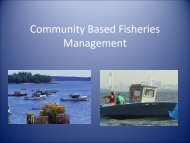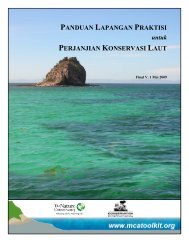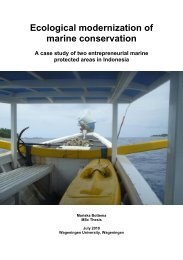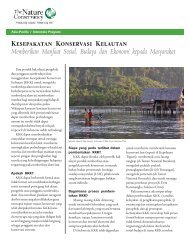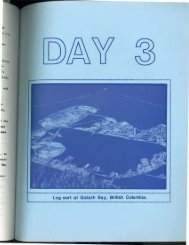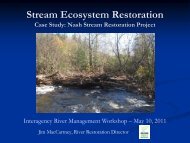Presentation
Presentation
Presentation
Create successful ePaper yourself
Turn your PDF publications into a flip-book with our unique Google optimized e-Paper software.
Ecosystem Tradeoffs<br />
Associated with Tidal Marsh<br />
Sills<br />
Karen Duhring<br />
Marine Scientist<br />
Virginia Institute of Marine Science<br />
International Submerged Lands Management Conference<br />
October 29, 2007
<strong>Presentation</strong> Outline<br />
Typical erosion protection projects in<br />
Virginia’s portion of Chesapeake Bay<br />
Preferred approaches from an ecosystem<br />
perspective<br />
Marsh sill case studies<br />
Summary of ecosystem tradeoffs<br />
associated with marsh sills
Typical Erosion Protection Projects<br />
on Virginia’s s Tidal Shorelines<br />
Revetments<br />
Bulkheads<br />
Bank Grading & Structures
Northumberland Co.<br />
County<br />
Lancaster Co.<br />
Permit site<br />
Potomac<br />
River<br />
Chesapeake<br />
Bay<br />
Tidal Shoreline Permit<br />
Sites<br />
Lower Northern Neck,<br />
VA<br />
1999-2007<br />
Widespread<br />
distribution<br />
regardless of energy<br />
Middlesex<br />
Co.<br />
Rappahannock River<br />
Cumulative impacts<br />
throughout<br />
watersheds
Cumulative Impact of<br />
Shoreline Hardening<br />
Cumulative length new<br />
structures permitted<br />
each year<br />
18.2 miles / yr average<br />
Cumulative length<br />
permitted 1993-2006<br />
255.5 miles<br />
Direct loss & isolation<br />
of tidal wetlands<br />
Source:<br />
VIMS Tidal Shoreline Permit Database
Order of Preferred Approaches<br />
for Shoreline Protection<br />
1. No Action<br />
Leave shoreline in<br />
natural condition or<br />
restore habitats<br />
Reduce risk through land<br />
use changes<br />
2. Non-Structural<br />
Maximize vegetation<br />
cover
Order of Preferred Approaches<br />
for Shoreline Protection<br />
1. No Action<br />
Leave shoreline in<br />
natural condition or<br />
restore habitats<br />
Reduce risk through land<br />
use changes<br />
2. Non-Structural<br />
Maximize vegetation<br />
cover<br />
3.“Hybrid”<br />
Use structures to support<br />
natural erosion buffers<br />
(e.g. tidal marshes,<br />
beaches)<br />
4. Revetments<br />
5. Bulkheads
Preferred Approaches<br />
that may affect public submerged lands<br />
Tidal marsh enhancement or creation<br />
Beach nourishment in sand-limited system<br />
Bank grading with cut and fill to create or enhance<br />
tidal marsh<br />
Offshore breakwater systems for high-energy beach<br />
shorelines<br />
Tidal marsh sills for low to medium energy shorelines
Gapped sills with backfill from<br />
graded bank<br />
Marsh Sill<br />
with Planted Marsh<br />
Low profile revetment<br />
backfilled with sand to<br />
create or enhance tidal<br />
marsh<br />
Imported sediment from<br />
upland source or suitable<br />
bank grading material<br />
Offensive approach<br />
structures built in sand transport<br />
region to address impinging waves<br />
before they reach upland areas
Typical Sill Cross-Section<br />
Planted tidal marsh<br />
Height near mean high<br />
water elevation<br />
Average 20-30 feet<br />
Source: Jefferson Patterson Park project, Maryland
Marsh Toe Revetment<br />
Natural Marsh Edge Stabilization<br />
Low profile<br />
revetment placed<br />
along the eroding<br />
edge of existing<br />
tidal marsh
VIMS Study<br />
36 marsh structures in 2004-2005<br />
2005<br />
A Survey of the Effectiveness of<br />
Existing Marsh Toe Protection<br />
Structures in Virginia<br />
July 2006<br />
K.A. Duhring, T.A. Barnard &<br />
C.S. Hardaway, Jr.
Marsh Sill at VIMS<br />
Marsh Sill at VIMS<br />
since 1983<br />
Salt Bushes<br />
Saltmarsh Cordgrass<br />
Stone Sill
Before<br />
After 1 year<br />
High, vertical, sandy bank<br />
Undercutting erosion at bank toe<br />
Narrow, patchy fringe marsh + 5 ft wide<br />
Tidal creek with regular boat wakes<br />
Graded bank now stable<br />
Suitable material used for backfill<br />
Planted tidal marsh + 25 ft wide<br />
Gapped sills (3)
Combination Approach<br />
Graded Bank with cut & fill + Planted Tidal Marsh + Gapped Sills<br />
Tidal opening<br />
Saltmeadow hay<br />
Spartina patens<br />
Smooth<br />
cordgrass<br />
Spartina<br />
alterniflora<br />
Approx. mean high water<br />
+ 25 feet
Before<br />
After 1 year<br />
Regular high<br />
tides<br />
Remnant tidal marsh at high<br />
energy setting<br />
Extensive beds of submerged<br />
aquatic vegetation (SAV)<br />
Existing revetment stabilizing<br />
bank<br />
Desire to protect 1 oak tree from<br />
saltwater intrusion<br />
“Perched” marsh not<br />
accessible to marine organisms
Tidal Openings<br />
Straight<br />
Offset<br />
gapped<br />
Offset end at<br />
upland revetment
Before<br />
After 10 years<br />
Non-vegetated sand/mud,<br />
narrow intertidal zone<br />
Open water (before sill)<br />
Sediment movement<br />
Nutrient cycling by infaunal<br />
community<br />
Eroding upland bank (not<br />
visible)<br />
Stone sill & wide vegetated intertidal area<br />
Less open water area<br />
Sediment trapping<br />
Nutrient cycling by marsh plants and infaunal<br />
community<br />
Stable upland bank with dense vegetation (not<br />
visible)
Aerial habitat<br />
Polychaete worms, crustaceans, molluscs<br />
Bivalves – clams, oysters, mussels<br />
Essential prey for blue crab, benthic<br />
feeding fish (e.g. spot, croaker)<br />
Habitat Diversity<br />
Comparison<br />
spiders, insects, wading birds, waterfowl,<br />
mammals<br />
Marsh surface & belowground<br />
microbial fungi and bacteria, algae,<br />
meiofauna (nematodes, copepods, rotifers,<br />
protozoa)<br />
Foraging invertebrates (polychaetes,<br />
gastropod mollusks, fiddler crab, blue crab,<br />
amphipods)<br />
Filter feeders (ribbed mussel, oyster)<br />
Aquatic pools and channels<br />
Small & juvenile fish, shrimp, blue crab
Habitat in Riprap<br />
Reefs<br />
Lower diversity &<br />
abundance than marshes<br />
& oyster reefs<br />
May support similar or<br />
higher nekton abundance<br />
than bare sediment
Potentially Negative Effects of<br />
Marsh Sills<br />
Covering shallow water benthic infauna<br />
Hydrodynamic changes - altering tidal<br />
exchange, wave height and wave direction<br />
Construction access & maintenance<br />
impacts<br />
Altering sediment transport <br />
Altering habitat use at marsh edge
Potentially Positive Effects<br />
Wave attenuation including boat wakes<br />
Sediment stabilization<br />
Vegetation stabilization<br />
Allows for efficient nutrient cycling, complex habitat<br />
structure<br />
Tidal marsh creation and restoration<br />
Protection and restoration of salt marsh habitats may be essential<br />
to the maintenance of high benthic production and consumer<br />
biomass in estuarine ecosystems (Seitz et al 2006)<br />
Habitat diversity & complexity<br />
For terrestrial, wetland and aquatic organisms
Current Guidelines for Marsh Sills<br />
Use only if action is required and nonstructural<br />
methods are not sufficient<br />
Minimize channelward encroachment<br />
Make structure as porous & low as possible<br />
Minimize / restore construction access<br />
impacts<br />
Periodic maintenance required<br />
Pruning overhanging branches, removing excess<br />
tidal debris, replacing scattered stone, additional<br />
planting
Main Conclusions about<br />
Tradeoffs<br />
Marsh sills are better choice for erosion protection<br />
in low & medium energy settings than bulkheads<br />
Not as appropriate at high energy settings or where<br />
significant aquatic resources would be impacted<br />
(e.g. SAV, unique shellfish areas)<br />
Tidal marsh creation & restoration at the land-water<br />
interface is beneficial for public trust resources<br />
More research is needed & underway to compare<br />
actual productivity before and after sill construction,<br />
evaluate effects of tidal gaps
Any Questions About Marsh Sills



